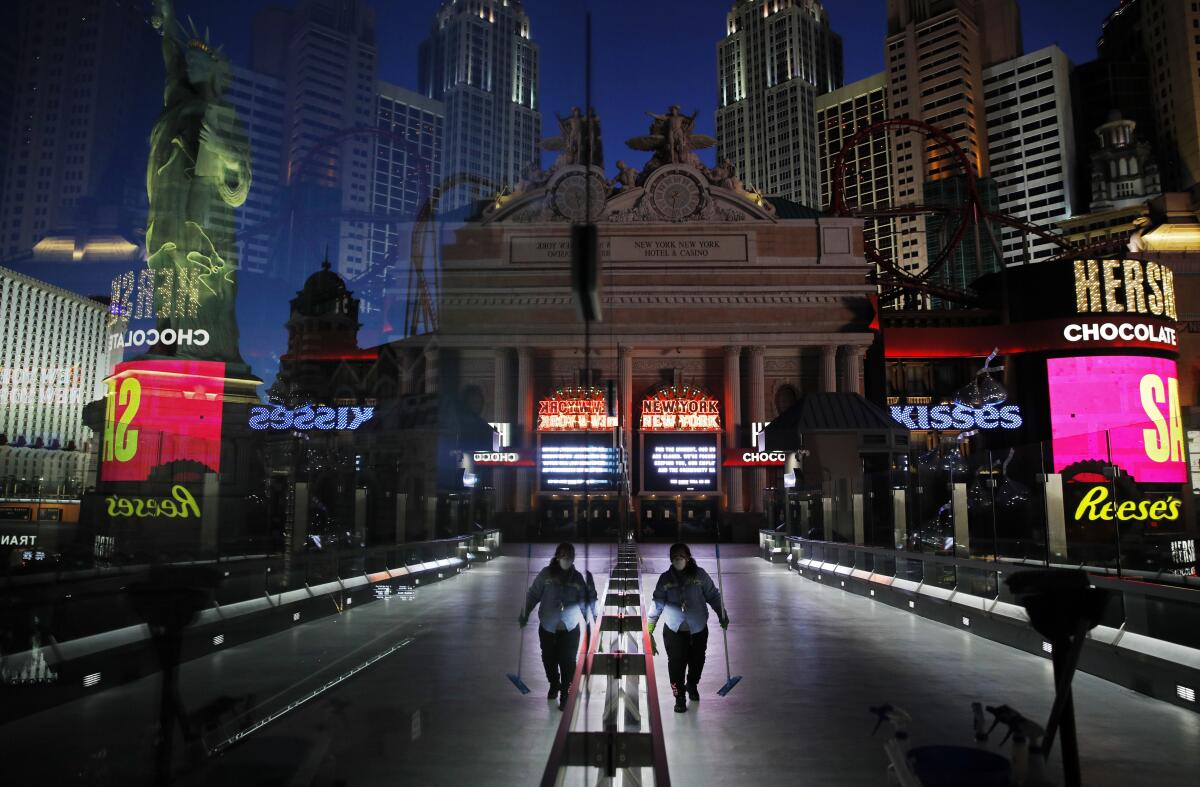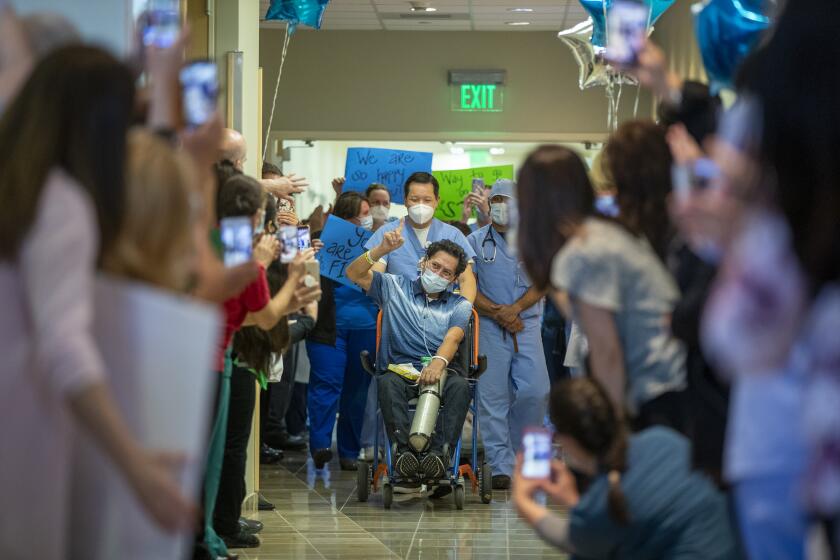U.S. economy, in clear sign of recession, shrinks 4.8% in first quarter due to coronavirus

- Share via
WASHINGTON — In the broadest measure so far of COVID-19’s economic damage, the government said Wednesday that total U.S. output in the first quarter fell at a 4.8% annual pace — faster than at any time since the Great Recession.
But economists quickly noted that even this decline was likely the tip of the iceberg because the first-quarter number included January and February, and reported coronavirus cases did not begin to surge until March. The full dimension of the pandemic’s economic damage will not be visible in the data until the second quarter.
“Overall economic activity will likely drop at an unprecedented rate in the second quarter,” said Federal Reserve Chair Jerome Powell. He vowed strong policy action from the central bank and said that Congress needed to do more to support the economy.
“This is an extraordinary, extraordinary shock, unlike any that’s happened in my lifetime,” Powell said at a video news conference Wednesday following the Fed’s policy meeting.
These are some of the unusual new scenes across the Southland during the coronavirus outbreak.
Wednesday’s economic report left little doubt that the nation’s record 10½ years of economic expansion has come to an abrupt end, with profound political and economic repercussions.
A recession poses serious challenges to President Trump’s reelection strategy, which was designed to capitalize on now-vanishing prosperity.
The pandemic also creates potential problems for Democrats hoping to rely on traditional campaign rallies and other methods of building support.
Two consecutive quarters of negative growth in the gross domestic product — a tally of all goods and services produced in the nation — are usually considered a recession. And the U.S. economy got much worse in April as businesses across the nation shut down, millions of workers were laid off, state governments imposed lockdowns, and claims for unemployment benefits skyrocketed.
Economists have projected the GDP will crater in the second quarter by a record annual rate of 30% or more.
“It’s just the first leg of our journey,” Joel Prakken, chief U.S. economist at IHS Markit, said of Wednesday’s report from the Commerce Department.
The research firm now sees a 37% annualized plunge in GDP for the current quarter. The steepest quarterly drop during the Great Recession was 8.4% in early 2009.
“This is going to blow that out of the water,” Prakken said.
The GDP grew at a moderate 2.1% pace in the fourth quarter of last year and by 2.3% for all of 2019. The numbers are adjusted for inflation.
In one hopeful sign, Prakken and others said the second quarter could very well turn out to be the bottom for the economy because some states already have begun to allow businesses to reopen, and eased up on lockdowns and restrictions for public gatherings.
The economy should also be getting a lift from the nearly $3 trillion in various relief spending by Congress — including more than $650 billion aimed at small businesses — and trillions more in lending and credit programs orchestrated by the Fed.
The Fed responded swiftly to the coronavirus outbreak, slashing its benchmark interest rate to near zero in mid-March and announcing multiple lending facilities, including support for budget-strapped states and cities, to limit business failures and job losses.
Powell told reporters that Fed officials are “not going to be in any hurry” to raise rates or withdraw other policy support for the economy.
Stocks rallied Wednesday as investors were buoyed by hopes that a drug would soon be developed to treat COVID-19. The Dow Jones industrial average surged 532 points, or 2.2%, to close at 24,634.
Stock markets have made a strong recovery in recent days as more states have moved to relax lockdowns and reopen the economy. Many analysts, however, said that the outlook for the economy and corporate earnings does not support the price gains.
“Equity market investors are whistling by the COVID graveyard,” said Diane Swonk, chief economist at the accounting firm Grant Thornton in Chicago.
“You really get the sense that the stock market, Wall Street, has disconnected from Main Street entirely, and is looking at a much more robust recovery than can occur, even in the best-case scenarios.”
Even if easing of social distancing rules does not trigger a secondary surge of infections that forces another pullback, a short-lived downturn does not necessarily mean a quick return to pre-pandemic times.
“The ongoing public health crisis will weigh heavily on economic activity, employment, and inflation in the near term, and poses considerable risks to the economic outlook over the medium term,” the Fed said in its policy statement Wednesday. Powell described the medium term as a year or a little longer.
Although the U.S. economy could start growing again this fall, most economists see a halting recovery given the uncertainty of the medical situation and the magnitude of the financial losses to businesses and consumers, who account for the bulk of U.S. economic activity.
Consumer spending in the first quarter tumbled at a 7.6% pace as purchases of cars and other big-ticket items tanked in March, as they did for travel and a host of services, including visits to restaurants and dentists’ and doctors’ offices.
The April consumer confidence index by the University of Michigan saw the biggest drop in nearly half a century. The survey found, for example, that Americans now view home-buying less favorably than at any time since 1984 — despite unusually low interest rates.
“It’s not going to be easy to turn the economy back on like a light switch,” said Chris Rupkey, chief financial economist at MUFG Union Bank in New York. “The harder the sales fall, the harder to get consumers reengaged with the economy and get spending back to prior levels.”
Recovery after the Great Recession of 2008-09 was slow because it took years to restore and repair the financial condition of households and institutions deeply scarred by the financial crisis and the bursting of the housing bubble.
This time, many would-be consumers are likely to emerge from the pandemic with heavy debts and other liabilities.
The current economic troubles have no clear historical precedents, but the severity of the downturn, coupled with the uncertainty surrounding the health threat, suggests that businesses and households will be cautious for many months down the road.
“You’ll still be left with probably a level of caution on the part of people who will worry and probably keep worrying for some time,” Powell said.
After the Great Recession ended in June 2009, it took about two years for the economy to regain the output level before the downturn.
An economic recovery from the health crisis could take as long, although IHS’ Prakken said the employment situation would be particularly tricky to forecast because of the sudden collapse in jobs and unusual incentives in the aid package to retain or rehire workers.
“I think you could see a quicker decline in unemployment and a quicker increase in employment in this recovery,” he said.
In the first quarter, the pace of business capital spending and investments fell 5.6%. And many company owners are eyeing the future warily.
Parker Boiler in Commerce, Calif., was certified as an essential business and has remained open. Co-owner Greg Danenhauer said the manufacturer has kept all 65 employees on the payroll at its 50,000-square-foot plant.
But even with a backlog to keep production workers busy, Parker’s sales were off 10% in the first quarter, and Danenhauer said the company could be looking at a 30% to 40% fall in revenue in the current quarter.
His customers include dry cleaners, hotels, breweries and hospitals. Some of them are closed, others cannot get permits now, and still others have decided to put off or cancel their orders.
“My salesmen all tell me the same thing,” said Danenhauer. “People are not doing new projects. The mechanical engineers, or steam kettle manufacturers, the guys making presses or rubber baskets — they’re not quoting new things or designing them.”
He added: “I can tell you, when Trump got elected in November [2016] more people started calling in and started doing projects. There was just a level of optimism at that point. Right now, everybody’s sort of like, let’s wait and see what’s going on.”
More to Read
Get the L.A. Times Politics newsletter
Deeply reported insights into legislation, politics and policy from Sacramento, Washington and beyond. In your inbox twice per week.
You may occasionally receive promotional content from the Los Angeles Times.











